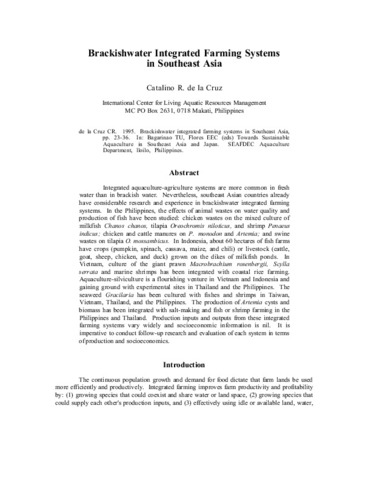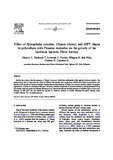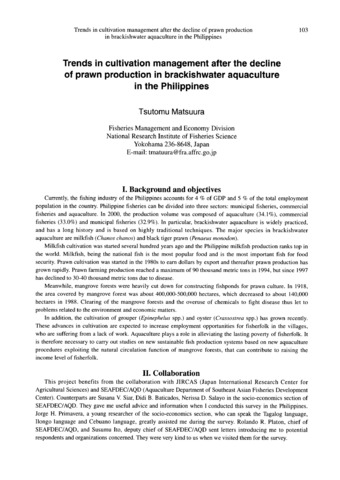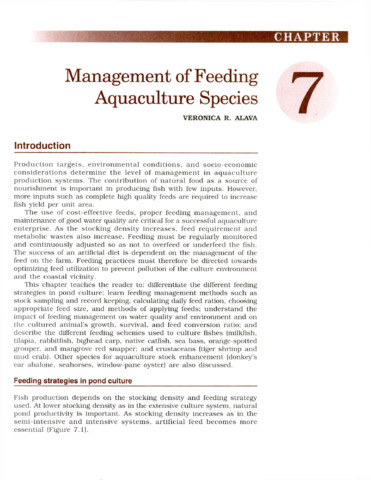Brackishwater integrated farming systems in Southeast Asia
- Global styles
- MLA
- Vancouver
- Elsevier - Harvard
- APA
- Help

วันที่
1995ผู้เขียน
Page views
7,990ASFA keyword
AGROVOC keyword
Taxonomic term
เมตาดาต้า
แสดงระเบียนรายการเต็ม
Share
นามธรรม
Integrated aquaculture-agriculture systems are more common in fresh water than in brackish water. Nevertheless, southeast Asian countries already have considerable research and experience in brackishwater integrated farming systems. In the Philippines, the effects of animal wastes on water quality and production of fish have been studied: chicken wastes on the mixed culture of milkfish Chanos chanos, tilapia Oreochromis niloticus, and shrimp Penaeus indicus; chicken and cattle manures on P. monodon and Artemia; and swine wastes on tilapia O. mossambicus. In Indonesia, about 60 hectares of fish farms have crops (pumpkin, spinach, cassava, maize, and chili) or livestock (cattle, goat, sheep, chicken, and duck) grown on the dikes of milkfish ponds. In Vietnam, culture of the giant prawn Macrobrachium rosenbergii, Scylla serrata and marine shrimps has been integrated with coastal rice farming. Aquaculture-silviculture is a flourishing venture in Vietnam and Indonesia and gaining ground with experimental sites in Thailand and the Philippines. The seaweed Gracilaria has been cultured with fishes and shrimps in Taiwan, Vietnam, Thailand, and the Philippines. The production of Artemia cysts and biomass has been integrated with salt-making and fish or shrimp farming in the Philippines and Thailand. Production inputs and outputs from these integrated farming systems vary widely and socioeconomic information is nil. It is imperative to conduct follow-up research and evaluation of each system in terms of production and socioeconomics.
การอ้างอิง
de la Cruz, C. R. (1995). Brackishwater integrated farming systems in Southeast Asia. In T. U. Bagarinao & E. E. C. Flores (Eds.), Towards Sustainable Aquaculture in Southeast Asia and Japan: Proceedings of the Seminar-Workshop on Aquaculture Development in Southeast Asia, Iloilo City, Philippines, 26-28 July, 1994 (pp. 23-36). Tigbauan, Iloilo, Philippines: Aquaculture Department, Southeast Asian Fisheries Development Center.
Type
Conference paperISBN
971851127Xคอลเลกชัน
- ADSEA '94 [21]
Related items
Showing items related by title, author, creator and subject.
-
Effect of Epinephelus coioides, Chanos chanos, and GIFT tilapia in polyculture with Penaeus monodon on the growth of the luminous bacteria Vibrio harveyi
Tendencia, Eleonor ; Fermin, Armando C.; dela Peña, Milagros R.; Choresca, Casiano H., Jr. (Elsevier, 2006)
Studies have shown that the presence of Tilapia hornorum hybrid has antibacterial effect against luminous bacteria. The present study aims to determine the effect of different fish species such as grouper, milkfish and ...
; Fermin, Armando C.; dela Peña, Milagros R.; Choresca, Casiano H., Jr. (Elsevier, 2006)
Studies have shown that the presence of Tilapia hornorum hybrid has antibacterial effect against luminous bacteria. The present study aims to determine the effect of different fish species such as grouper, milkfish and ... -
Series: JIRCAS Working Report;No. 35
Trends in cultivation management after the decline of prawn production in brackishwater aquaculture in the Philippines
Matsuura, Tsutomu (Japan International Center for Agricultural Sciences, 2003)A survey was conducted in Regions 1 (Ilocos), 3 (Central Luzon), 6 (Western Visayas) and 7 (Central Visayas) of the Philippines between 20 May and 25 July 2002. Questionnaires were distributed and interviews were performed ... -
Management of feeding aquaculture species
Alava, Veronica R. (Aquaculture Department, Southeast Asian Fisheries Development Center, 2002)This chapter teaches the reader to: differentiate the different feeding strategies in pond culture; learn feeding management methods such as stock sampling and record keeping, calculating daily feed ration, choosing ...






